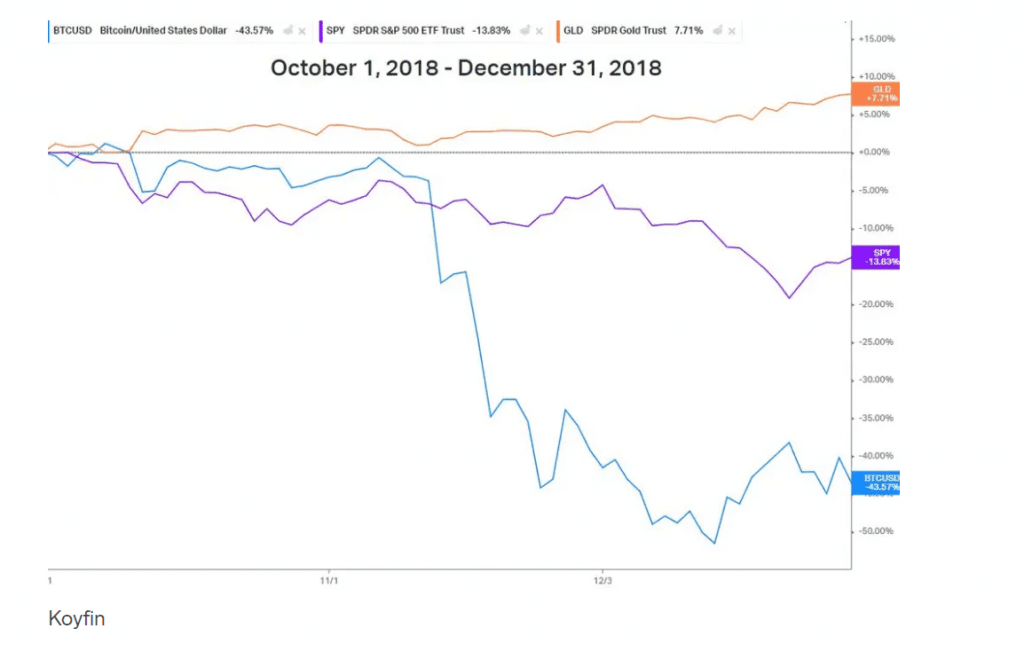Going mainstream is not always the best outcome for assets, and cryptocurrencies have lent proof to the same. While a rise in adoption had definitely brought legitimacy and capital to the market, it has also made it susceptible to macroeconomic changes.
Crypto is stocking up
This has been highlighted in the rising correlation between cryptocurrency and U.S Stock market prices, which has been a worrying trend for analysts for quite a few years. This was accelerated last month when the U.S Federal Reserve’s hawkish stance and inflation reporting sent both markets tumbling down.
Now, as both asset classes enter a period of stability, these fears have been freshly invoked, especially since a number of announcements are expected to be rolled out by the Fed in the coming week.
Historical data has shown that a positive correlation between stocks and crypto was first noted in 2018 when similar tapering by the Fed had crashed both markets. While stocks fell nearly 20% in the fourth quarter of 2018, Bitcoin fell as much as 50%.
Source: Business Insider
However concerning the trend may have been earlier, its unparalleled acceleration since August 2021 has sent many into a dizzy. Over the past month, Bitcoin has fallen 12% against the dollar, while the S&P has gone down 10%, indicating that the gap between both is narrowing with each crash.
Martin Green, CEO of Cambrian Asset Management noted the same in a recent Forbes interview, highlighting that while the Bitcoin-Nasdaq correlation was 0.2 over the last three years, “in the last several weeks, it has doubled to around point four.” He added,
“There is a higher correlation today than there was six months ago… I would say that recently along the two axis – up and down – Bitcoin and tech stocks are in tandem because of interest rates and inflation concerns that have affected stocks and crypto.”
Safe haven no more
Crypto and tech stocks moving in tandem could cause many hurdles to global finance, as pointed out by the International Monetary Fund (IMF) recently. Among these include the risk of contagion that could cause investor sentiment to spillover between markets.
A spillover can also be noted between crypto assets, as a similar correlation between the second-largest cryptocurrency Ether, and the S&P 500 has breached record highs.
This has eaten into BTC’s narrative of being a safe haven asset akin to, or better than, Gold. This was behind much of its earlier popularity, argued ChangeNOW spokesperson Mike Ermolaev in the same interview.
He said that while macro trends were a contributing factor towards BTC economic evolution, its mainstream adoption by institutional investors could also have played its part. While outflows from BTC investment products have hit a record high lately, the larger investment cohort has been increasingly bullish on the nascent asset.
Even as this has brought legitimacy to the industry, it could also lead to money managers’ treating the asset similar to traditional tech stocks, thus adding to the correlation.
“There has been a lot of money flowing into crypto from traditional markets these past couple years. During that time, traditional markets and cryptocurrency markets have converged. It’s evident from various indicators that tech stocks and Bitcoin are strongly correlated right now.”
Fortunately, a silver lining prevails amidst the chaos, as Bitcoin and Ether tracking the traditional stock market could mean a surge in these assets’ prices whenever the shares take an upturn.
Moreover, the growth in institutional interest and long-term holders is a signal that the market is maturing and eroding its risk factor. Bitcoin tracking the S&P or the NASDAQ could add to this narrative even further.



